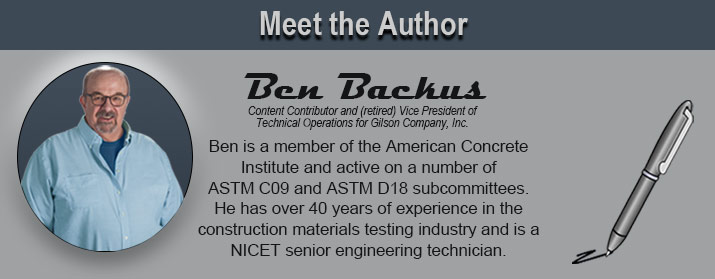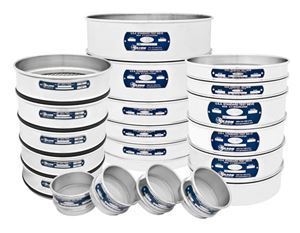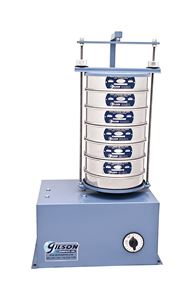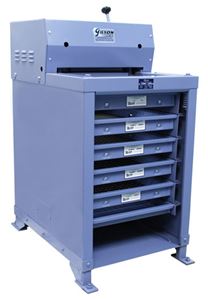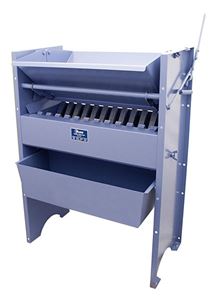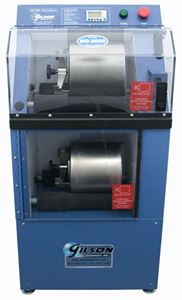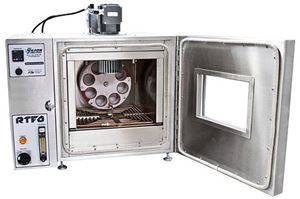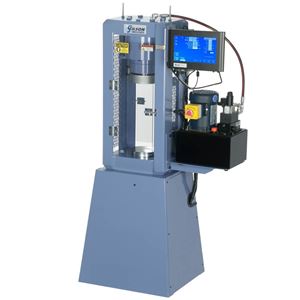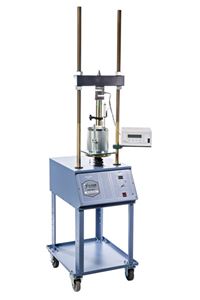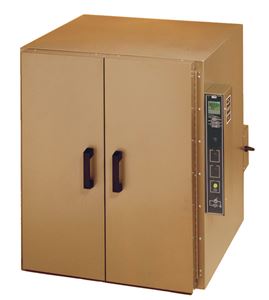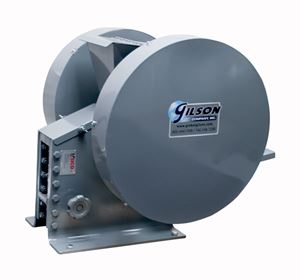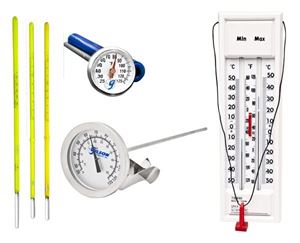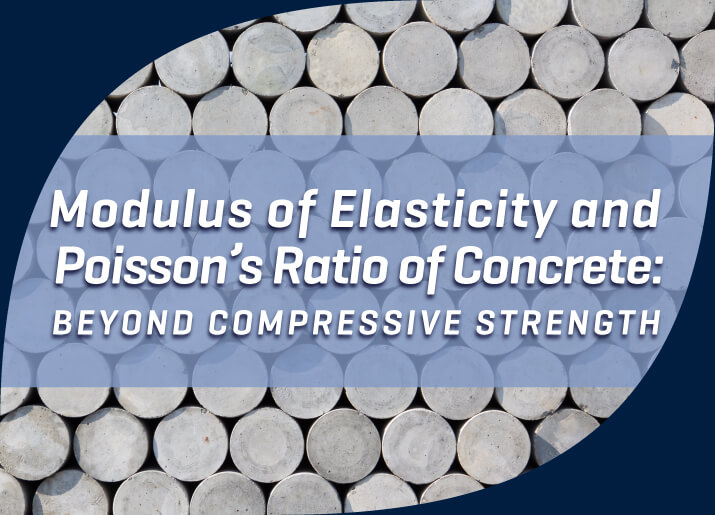
Benefits of MOE and Poisson’s Ratio Tests With Automated Compression Machines
For most concrete test cylinders, a 7- or 28-day strength test in a compression testing machine is the end of the line. Even so, these ubiquitous concrete samples readily reveal a more complete strength profile with some extra effort and increased instrumentation.
What is Elastic Modulus & Poisson’s Ratio?
The modulus of elasticity (MOE), or Young’s modulus, is essentially the stiffness of a concrete mixture, an indication of how much concrete can safely deform under an axial load. When designers know both strength and stiffness, they can accurately calculate the shapes and sizes required for structural elements to perform well and have a long service life.
Poisson’s ratio is a dimensionless expression of the deformation of a specimen perpendicular to the direction of the load. The typical ranges of Poisson’s ratio values for concrete are 0.15 to 0.20 for normal weight concrete, 0.10 to 0.15 for lightweight mixes, and 0.20 to 0.25 for high-strength concrete.
Concrete Under Pressure
When concrete is loaded axially, as in a compression test, its dimensions change. As you might expect, the axis shortens and the sides bulge out horizontally. If the applied load remains within the limits of its elastic modulus, the deformation is not permanent; the structural member recovers its original shape when unloaded and retains its strength characteristics.
Historically, measuring the modulus of elasticity (MOE) and Poisson’s ratio of concrete samples was not routinely done for every structural application or mix design. The complexity of sample preparation and instrumentation, as well as the recording of data points and precise control of loading forces, made performing the ASTM C469 procedure difficult and expensive.
MOE & Poisson’s Ratio in Design Practice
It is accepted practice for structural design professionals to use assumed, nominal MOE and Poisson’s ratio values to plan the dimensions of structural elements and the type of steel reinforcement required. Although there might be some variability between nominal and actual values, these values are adequate stand-ins when dealing with standard structural profiles and conventional concrete mixes. However, unique structures or special concrete mixes demand a critical level of accuracy that only measured values from ASTM C469 tests can provide:
- Codes or specifications may require actual testing to verify material properties.
- High-performance or other specialized concrete mixes are often sensitive to slight variations in elastic characteristics.
- Variability of component materials or batching practices can cause irregularities in elastic properties.
- Architectural designs may require structural elements (i.e., columns and walls) to have reduced footprints to increase floor space or enhance aesthetic appeal.
When structural engineers are compelled to validate their design with actual test values, they turn to reputable construction materials testing professionals for their answers. A testing laboratory equipped to perform the C469 MOE and Poisson’s ratio procedure efficiently stands out as a capable full-service facility that understands concrete quality.
Automated Compression Machines Open the Door
Most manually controlled compression testing machines cannot operate with the level of precision required to control the loads necessary for MOE and Poisson’s testing. Manual machines that can achieve this performance typically need two people to perform the ASTM C469 procedure when analog instruments are used. One person controls the application and maintenance of loads, while another person records deformation readings from the dial gauges at the required intervals.
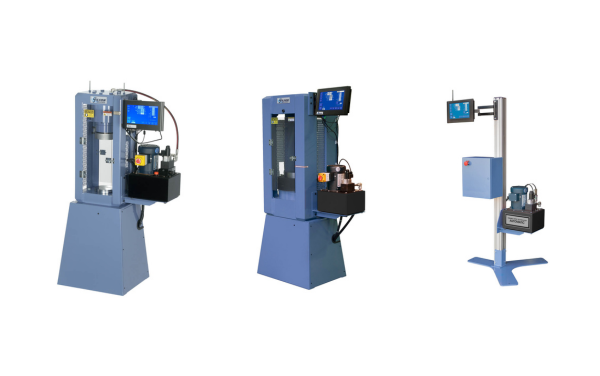
AC-250MR Compression Testing Machine, AC-650MR Compression Testing Machine, AC-209 Automatic Controller Retrofit
Gilson Automatic Compression Testing Machines with model number suffixes of “M” or “MR” are factory-configured to measure MOE, or MOE & Poisson’s ratio, respectively. These machines fully meet the requirements of C469 for precisely controlled cyclic application and release of specified loads when used with optional compressometer or compressometer/extensometer fixtures supplied by Gilson. M and MR units also perform fully automatic procedures for conventional compression, beam flexure, or splitting tensile tests following ASTM specifications.
Gilson’s M and MR series compression machines are designed with unique hydraulic manifolds and proportional valves, providing precise control of the piston during both loading and unloading phases. This allows smooth and precise pressure control during application, holding, and removal of loads throughout the user-specified number of loading cycles. These machines also include one or two input ports for LVDT length gauges and functionality to record, calculate, and report results following C469 requirements.
The Automatic Controller Retrofit is a cost-effective alternative for labs that have a manual compression machine in good operating condition. Retrofit kits, configured for MOE or MOE and Poisson’s ratio testing, and equipped with Gilson Guardian software, easily adapt manual machines to fully automatic operation.
MOE Test Methods & Practices
ASTM C469 requires testing at least two companion cylinders to establish compressive strength prior to MOE and Poisson’s testing. The standard also allows the MOE specimen to be tested to failure at the completion of testing but cites a need to protect instrumentation from damage if this option is implemented.
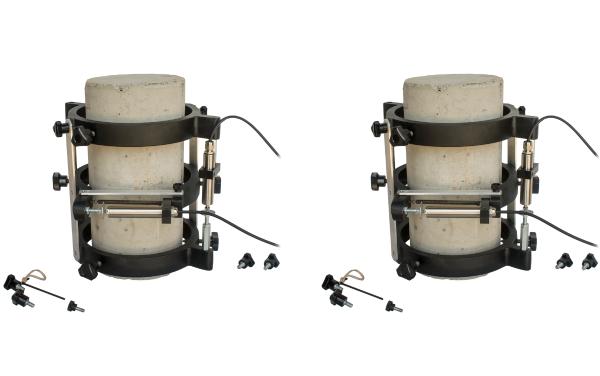
Gilson Compressometer and Compressometer/Extensometer
For MOE measurements in the C469 procedure, a 4in or 6in (102mm or 152mm) diameter concrete cylinder is fitted with an optional Compressometer accessory. This metal frame features two horizontal yokes for mounting instrumentation to measure deformation under axial loads. A Compressometer/Extensometer accessory determines both MOE and Poisson’s ratio, and features a third yoke to measure horizontal extension of the specimen.
To begin the procedure, the test method and relevant sample data are entered on the touch-screen display, and the appropriate testing frame is mounted on the test cylinder. The LVDTs are attached to the frame, and the instrumented cylinder is positioned on the bottom platen of the testing machine. The load value and the LVDTs are tared and zeroed, and the test is started.
For each cycle, the compression machine automatically loads the cylinder to 40% of its previously determined compressive strength at a rate of 35 psi/second, ±7 psi/s (250 kPa/s, ±50 kPa/s), and then unloads it at the same rate. The loading and unloading cycles continue based on the number initially programmed by the user. The test method requires at least three such cycles, with the first cycle primarily intended to seat the gauges.
Stress information from the applied loads and deformation readings from the LVDTs is automatically logged by the machine controller at the specified points. At the completion of the test, data is calculated, and MOE/Poisson’s values are displayed. Gilson Guardian software enables the generation of complete reports for each test, including stress-strain graphs.
Looking at MOE and Poisson’s in a New Light
This important characterization of concrete strength no longer needs to be considered as an expensive, complex, and time-consuming test. The equipment is accurate, efficient, and cost-effective, with minimal operator training required.
For manually operated compression machines, it’s estimated that each specimen may require ~30 to 45 minutes to mount the compressometer/extensometer, complete the loading/unloading cycles, and record the data. Then, an additional 10 to 20 minutes is needed for final calculations and the completion of stress-strain curves. At this rate, four to six tests per day could be completed using two operators.
M and MR Automatic machines require only one operator, and the time for a completed test, including loading and unloading cycles, as well as automatic logging of the readings, is condensed to ~10 to 20 minutes, as the operator is free to prepare the following sample for testing. The final calculations and creation of the stress-strain curves for each specimen are complete at the end of each test. The throughput for one operator and an automatic machine fitted with digital instruments could be as high as 20 to 30 tests per day.
We hope this article has helped you see the advantages of performing modulus of elasticity and Poisson’s ratio tests using automated compression machines and digital instrumentation. Please contact the testing experts at Gilson to discuss your applications.
References
- ASTM C39, Standard Test Method for Compressive Strength of Cylindrical Concrete Specimens
- ASTM C469, Standard Test Method for Static Modulus of Elasticity and Poisson's Ratio of Concrete in Compression
Gilson Is Here to Help
Contact our testing experts for more information or to discuss your testing application.
Testing Resources
Standard Test Methods, Specifications, and Practices
Individual test methods and specifications referenced in our product descriptions, blog articles, and videos are available for review or purchase from the professional organizations noted.
- ASTM International (American Society for Testing and Materials)
- AASHTO (American Association of State Highway and Transportation Officials)
- ACI (American Concrete Institute)
- State DOTs (Departments of Transportation)
- ISO (International Organization for Standardization)
- BS (British Standards)
- EN (European Standards)
